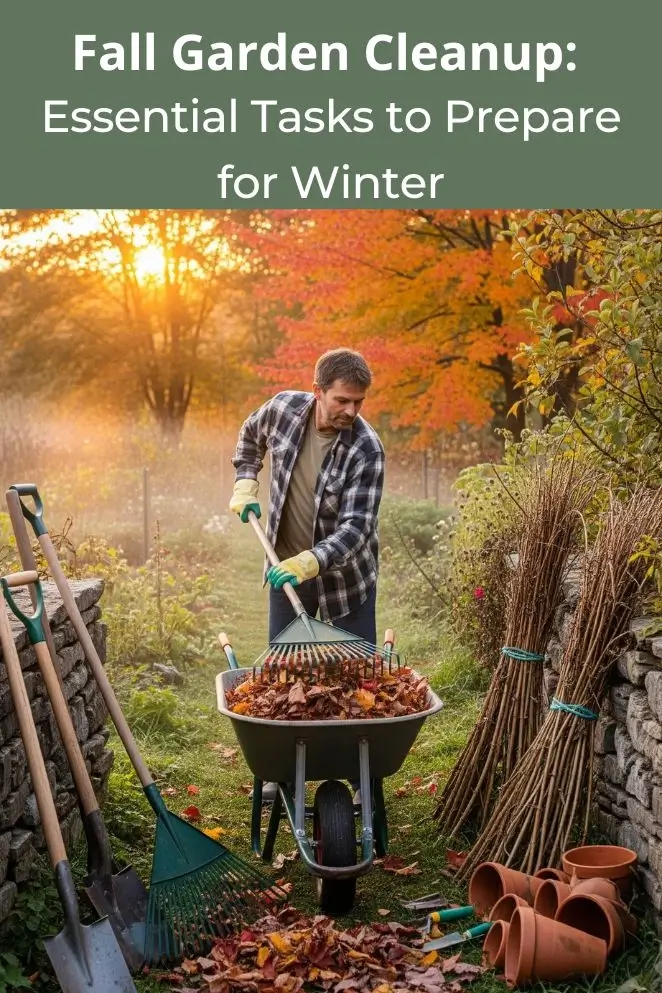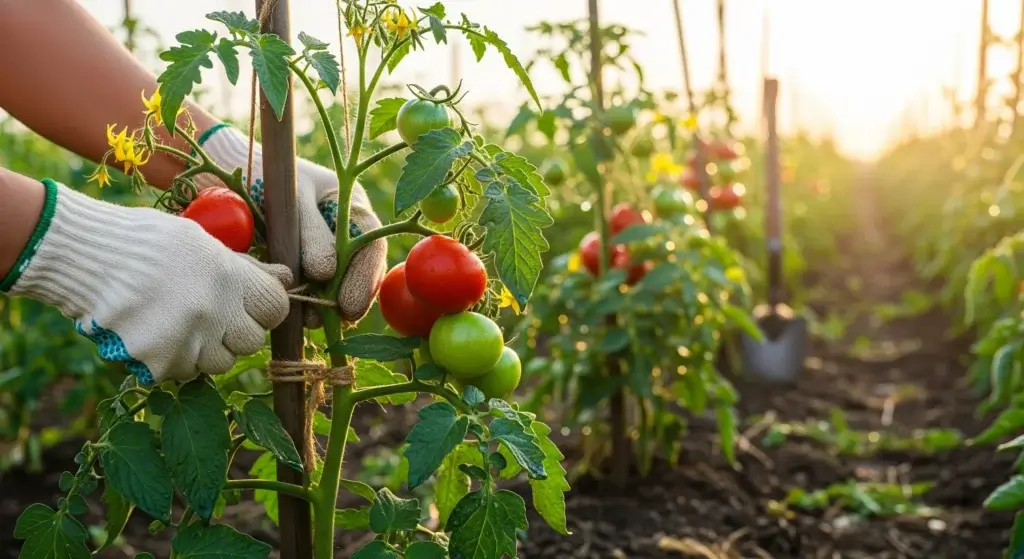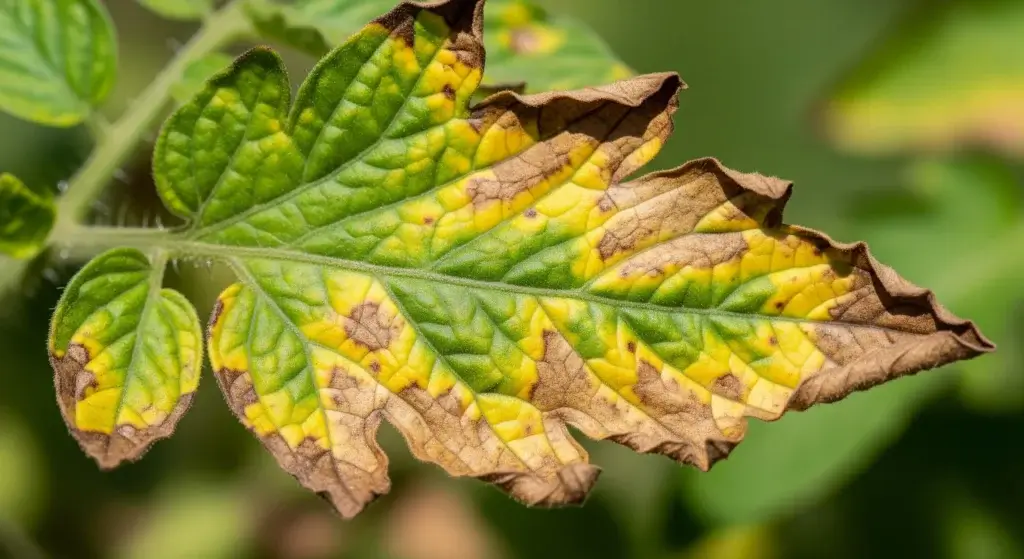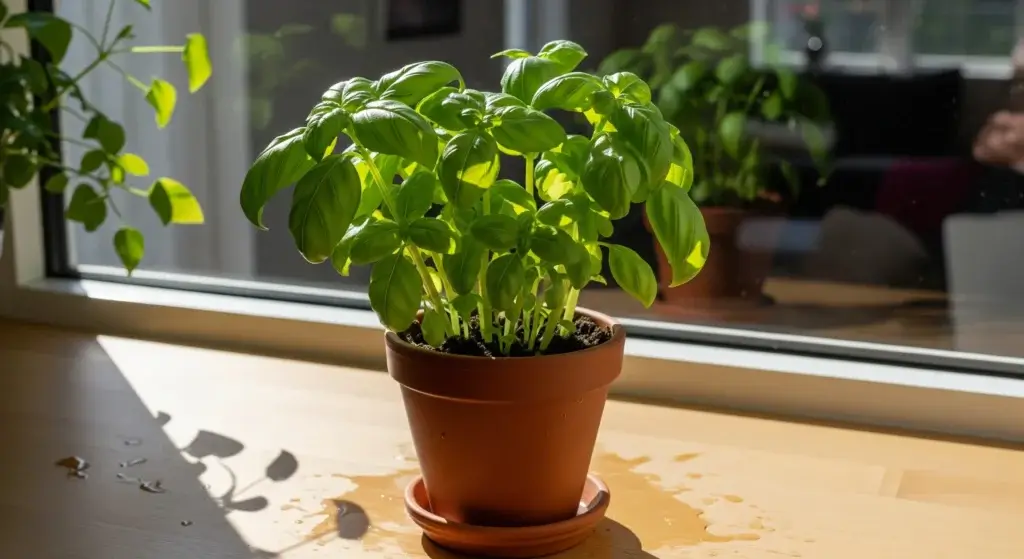
As autumn leaves start tumbling and the air gets chilly, real gardeners know fall isn’t “the end”—it’s game time.
The stuff you do now decides if your garden bounces back strong in spring or limps along like it just ran a marathon barefoot.
Think of fall cleanup as tucking your plants in for winter.
Skip it, and you’ll wake up in spring to a messy, half-dead jungle.
Do it right, and boom—your garden wakes up like it just had the best nap ever.
This guide is basically your cheat code for making sure your plants don’t just survive winter, but come back swinging.
Why Fall Garden Cleanup Matters More Than You Think
Fall cleanup isn’t just about making your yard look pretty—it’s about giving your garden a fighting chance.
- Disease Prevention: Ever left dirty dishes in your room? Yeah, gross. Fallen leaves and dead plants are basically dirty dishes for plant diseases, they’ll just sit there and spread.
- Pest Control: Bugs love a cozy winter Airbnb made of plant debris. Kick them out now, and you won’t have to deal with a full-blown pest party in spring.
- Soil Health: Your soil’s like an athlete—it needs training and good food even off-season. Add the right stuff in fall, and by spring it’ll be ripped and ready to grow.
- Plant Protection: Winter can be brutal. Think of cleanup as giving your plants a warm blanket so they don’t get wrecked by frost or random weather mood swings.
Essential Fall Cleanup Tasks: Your Complete Checklist
1. Clear Out Annual Plants and Spent Vegetables
Fall’s first move: yank the stuff that’s done. Annuals and tired veggie plants are just taking up space and hosting drama (diseases, pests).
- Vegetable garden cleanup: Pull out spent tomatoes, peppers, squash, beans — the whole sad parade. If they looked healthy, toss them in the compost.
- Annual flower removal: Rip out marigolds, petunias, impatiens once frost kills them. If a plant gave you good vibes, save its seeds for next year.
- Weed elimination: Get weeds before they drop seeds and become your backyard roommates for life. Do it now or regret it next summer.
2. Prune and Trim Perennial Plants
Perennials need finesse, not a haircut from a blender. Cut where it helps, leave what helps wildlife and winter vibes.
- Cut back herbaceous perennials: Snip most perennials down to 2–3 inches above the soil — hostas, daylilies, peonies — they’ll thank you in spring.
- Leave ornamental grasses and seed heads: Plants like echinacea and rudbeckia look cool in winter and feed birds. Let them stand until early spring unless they’re seriously messy.
- Prune roses carefully: Kill off dead or diseased canes, but don’t go savage — major pruning waits till late winter. Add mulch and chill.
- Tree and shrub maintenance: Remove dead or sick branches. Big cuts that trigger fresh growth? Save those for late winter so the cold doesn’t slap the new shoots.
3. Lawn Care and Maintenance
Your lawn is not lazy — it’s prepping for hibernation. Help it out and it’ll come back flexing.
- Final mowing: Keep mowing until grass stops growing, dropping the height gradually to about 2–2.5 inches for the last cut. That helps prevent snow mold and other nasties.
- Leaf removal: A thin leaf blanket is fine. A thick layer? That’s suffocation. Rake, bag, or mulch the leaves into the lawn.
- Overseeding and fertilizing: Fall is the cheat code for thicker turf. Overseed bare spots and put down a winter fertilizer with extra potassium so grass survives cold stress.
- Aeration: If the ground is compacted, aerate. Think of it like poking holes so roots can breathe and drink.
4. Protect Tender Plants and Shrubs
Some plants are drama queens about cold. Wrap them up, mulch them, or move their pots inside.
- Mulching: Lay 3–4 inches of organic mulch around trees, shrubs, and perennials — but keep mulch 2–3 inches away from stems to prevent rot.
- Wrapping sensitive plants: For roses, rhododendrons, or newly planted trees, a burlap wrap or cover can be the difference between survival and heartbreak.
- Container plant care: Move potted plants to a safer spot — an unheated garage, cold frame, or a south-facing wall — anywhere they’ll dodge extreme freeze-thaw swings.
5. Garden Tool and Equipment Maintenance
If your tools look like they survived a war, fix them now. You’ll love yourself in spring.
- Clean and oil tools: Remove gunk, oil metal parts, and sharpen pruners and shears. Dull tools make gardening feel like punishment.
- Drain and store hoses: Disconnect, drain, coil, and stash hoses so they don’t crack in a freeze.
- Equipment winterization: For gas gear, either run the tank dry or add stabilizer. Change oil and spark plugs if needed, and keep everything dry.
6. Soil Preparation and Amendment
Fall soil work = spring glory. Feed the dirt now and plants will reward you.
- Soil testing: Check pH and nutrients so you’re not guessing what the soil actually needs.
- Compost application: Spread 2–3 inches of compost on beds and lightly work it into the topsoil. Think of it as a spa treatment for your dirt.
- Cover crops: Plant winter rye or crimson clover in veggie beds to protect soil, reduce erosion, and add organic matter. Smart, low-effort win.
- Mulch pathways: Fresh mulch on paths keeps weeds down and the garden looking tidy — because yeah, presentation matters.
Advanced Fall Garden Strategies
Water Management and Drainage
If water’s pooling in your yard, you’re basically setting up a swamp for pests and root rot.
Fix it now and winter will be way less brutal.
- Improve drainage: Got spots that stay soggy? Mix in organic matter or set up drains. Roots hate sitting in cold muck all season.
- Clean gutters and downspouts: If your gutters are stuffed with leaves, rainwater’s gonna pour straight into your beds and drown plants.
- Winter watering: Evergreens don’t nap in winter — they’re still thirsty. Give them a deep drink before the ground freezes so they don’t dry out like old chips.
Planning for Next Year
Fall is like the post-game recap. You’ve still got the whole season fresh in your brain, so use it.
- Garden journaling: Jot down what crushed it and what flopped. Trust me, by spring you won’t remember why those tomatoes ghosted you.
- Seed ordering: The best seeds sell out fast. If you wait till spring, it’s like showing up late to a sneaker drop — all the good stuff’s gone.
- Garden design: While your wins and fails are still sharp in your head, sketch out new beds, expansion plans, or layout tweaks.
Regional Considerations and Timing
Not all gardens live the same life — what you do in fall depends on where you are.
Timing is everything, or you’ll either be scrambling in the frost or wasting energy too early.
- Northern climates (Zones 3–5): You’ve got to move fast. Start cleanup late September into early October, before the frost hits like a surprise exam.
- Moderate climates (Zones 6–7): You get a little breathing room. Cleanup can stretch into November, so you can pace yourself instead of sprinting.
- Southern climates (Zones 8–10): You’re not battling blizzards, but surprise freezes can still ruin your vibe. Prep for those random cold snaps instead of a full-on winter lockdown.
Common Fall Cleanup Mistakes to Avoid
Even pros mess this part up sometimes. Fall prep isn’t about going scorched-earth on your garden — it’s about balance.
- Over-cleaning: Don’t vacuum your garden spotless. Leaving seed heads and some debris gives birds food and bugs a place to crash (the good bugs, not the freeloaders).
- Premature mulching: If you mulch too early, you’re basically building a cozy pest hotel. Wait until a couple of hard frosts before tucking plants in.
- Ignoring microclimates: Your garden isn’t one uniform block. That sunny corner by the fence doesn’t need the same protection as the shady, windy patch.
- Forgetting about wildlife: If you cut down everything, birds and pollinators lose food and shelter. Think about them too — they’re part of the garden squad.
The Long-Term Benefits of Proper Fall Cleanup
Fall cleanup is like doing your homework now so spring feels like recess instead of detention.
- Reduced spring workload: Clean up right, and when spring hits, you’ll be planting instead of dragging soggy, gross plant corpses out of the dirt.
- Improved plant health: Plants prepped for winter don’t just survive — they come back stronger, like they spent all winter training for a comeback tour.
- Better pest and disease control: A good fall sweep breaks the cycle of bugs and plant diseases. Less drama, less spraying, less stress.
- Enhanced garden appearance: A winter garden that’s tidy but still alive with grasses, seed heads, and visiting birds just looks next-level.
Conclusion: Setting Your Garden Up for Success
Fall cleanup is basically an investment in future-you’s happiness.
Clearing out dead plants, protecting the sensitive ones, fixing up tools, and feeding the soil isn’t just closing the season — it’s setting the stage for a glow-up in spring.
This isn’t just tidying for Instagram aesthetics; it’s about knowing what your plants need and working with nature’s rhythm.
Do it all in one epic weekend or chip away over a few weeks — just finish before winter smacks your garden with ice and frost.
And yeah, the garden might look asleep in winter, but under the soil your prep is paying off, like behind-the-scenes training for a big comeback.
Put in the work now, and spring will feel like your garden’s dropping its best mixtape yet.



